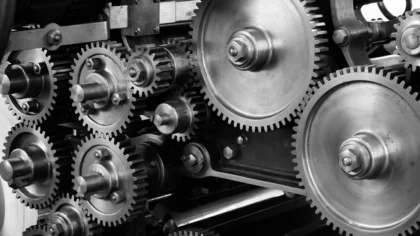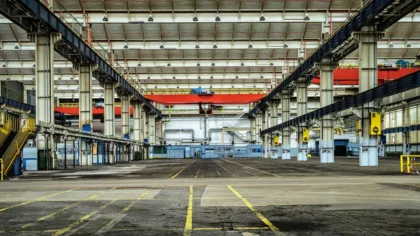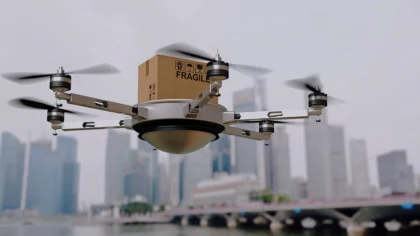Accelerate Productivity in 2025
Reignite Growth Despite the Global Slowdown
Similarly to how Virtual Reality (VR) is conquering the entertainment and gaming industries, it is becoming increasingly apparent that Augmented Reality (AR) constitutes a major disruption to the enterprise world, changing the way businesses operate, maintain their machinery, and train their employees.
Augmented reality provides a previously unattainable amount of insight and useful data regarding the working process, surroundings, and the workplace itself. Workers use augmented reality systems to get instant access to vast amounts of relevant data that eases the process of equipment maintenance, quality assurance during assembly, remote expert support during complex manufacturing processes (also referred to as telepresence) and more.
In the United States alone, it is estimated that by 2025 approximately 14 million workers will be using headsets in their workplace – an annual growth of 57% compared to 2017. Overall, AR creates a substantial value for employees and thus companies by blending the power of data and the ease of its application in real-world scenarios.
Manufacturing is one of the industries that stands to greatly benefit from augmented reality, equipping thousands of manufacturers with a competitive edge and an effective cost-cutting tool.
At StartUs Insights, we have thoroughly analyzed more than 400 global startups working on Augmented Reality solutions for the manufacturing industry to identify the most prospective application areas giving manufacturers the competitive edge they need in order to survive the digital transformation.
Augmented Reality In Manufacturing – The Innovation Map
Security & Safety
When it comes to the working environment, aside from making the manufacturing process smoother and more efficient, Augmented Reality makes working conditions much safer and aids workers in avoiding any harm as well as to prevent damage.
Augmented Reality solutions accurately predict non-planned work-related anomalies and possible malfunctions within the workplace, which reduces human and machine-centered mistakes, and, consequently, increases safety in the workplace.
Prototyping
Within the context of product design and development, AR-based systems support engineers to experiment with various designs and prototypes, making it much easier to display the preliminary stages and avoid engineering mistakes early on.
When 3D models of products come to life before they are mass-manufactured, it smoothes the development process and allows for a faster approval of new prototypes thus making the overall manufacturing process more efficient.
Work & Assembly Instructions
Adaptable and interactive up-to-date Augmented Reality work instructions and assembly guides are replacing complex manuals.
Employees receive AR-enabled step-by-step manuals and interactive guides superimposed onto the assembly line through the use of the workers’ smart headsets or glasses to facilitate a steeper learning curve and easier hands-free assembling process of heavy machinery, engines, cars, turbines, and more. Interactive Augmented Reality instructions are useful both for professionals aiming to increase their efficiency, and new hires to bring them up to speed quickly.
Manufacturing Training
Manufacturing industry employees need to be trained in a quick, insightful and efficient way – and Augmented Reality certainly accelerates this process. By enabling a more automated and user-friendly guidance to various aspects of the manufacturing process, AR guided training ensures a proper quality of the end-product.
For example, using an AR headset or a mobile device, trainees explore the internals of machines and its parts by just looking or pointing the device at them. Moreover, this AR-guided training proves to be beneficial to experienced workers as they are prepared to master new repair or assembly techniques, perfect their existing skills, and/or support the training of new hires in their team.
Real-Time Analysis & Digital Production Display Boards
Besides Augmented Reality instructions and information overlay, manufacturing startups are working on AR solutions to create powerful real-time analysis tools by combining advanced image recognition technologies, computing power, Internet of Things (IoT) devices, internal databases and Artificial Intelligence (AI) to provide meaningful insights into manufacturing operations.
While bearing resemblance to regular knowledge supplementation AR instruments, these solutions are much more sophisticated from a technological point of view.
For example, they are used to constantly monitor and overlay the real-time temperature of various machines during the maintenance process, collect and analyze vibration data, detect and identify issues with the machine’s operation based on its appearance, operational sound or other factors. Augmented Reality, in terms of this application, represents a powerful blend of quick in-house processing power with the mobility and practicality of a mobile device or an AR-enabled device.
Stock & Inventory Management
Augmented Reality tools ensure improved and more advanced stock & inventory management.
More specifically, AR engages warehouse workers in so-called “vision” or “guided” picking, which helps them to find the exact location of a certain package/product, and highlights it for easier pinpoint process and pickup. AR-guided picking helps warehouse workers effectively navigate towards needed supplies and make the overall process of order picking much faster and more efficient.
AR Manufacturing Startups Heat Map
The Heat Map below illustrates the geographical distribution of over 400 AR startups disrupting the manufacturing industry. The United States, the United Kingdom, France, Germany, India, and Israel are taking the lead. Many of these AR startups are clustered around urban areas with a strong presence of the creative and tech industries, such as Los Angeles, New York, London, and Paris. For more insights into the distribution check out our AR Manufacturing Startups Heat Map:
Here’s A List Of AR Startups Disrupting The Manufacturing Industry:
- Vital Enterprises develops software for AR glasses, mostly focusing on manufacturing companies to support them in enhancing their processes. The startup already has a large client pool, including Epson, Lockheed Martin, and SCM.
- DAQRI empowers workforces to be more efficient. The startup’s solutions DAQRI Worksense™ and DAQRI Smart Glasses® link digital content to the real world to accelerate productivity, communication, and key business processes.
- Inglobe Technologies develops HyperIndustry, a product that displays relevant areas under the hood of a car for engine repair training, as well as other tasks such as assisting employees in more complex tasks.
- RE’FLEKT designs in-house custom augmented reality and mixed reality (MR) applications. One of the startup’s products is Reflekt One, an AR platform for enterprises which allows them to create interactive manuals, as well as assist workers in the manufacturing processes. Another product, Reflekt Remote, enables easier and more efficient remote customer support through the usage of AR.
- Cratus Technology Inc. is a sensor-centric IoT product development company. Their product, BlueBrain is capable of collecting data from hundreds of combinations of sensors and transmitting that data in real-time to augmented and virtual reality headsets.
While augmented reality is already showing promising results and is becoming an indispensable part of manufacturing processes, there is much more to come considering the technology’s usability and versatility. It is not just about AR making workplace processes more interactive and adaptable, but about how AR introduces another dimension for interaction with the outside world and allows for combining the power of data and analytics with manufacturers’ everyday routines – a mix that is changing the way businesses are run.
Manufacturing companies aiming to stay ahead tomorrow need to invest in understanding how this technology impacts and disrupts their industry.









